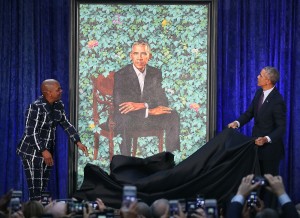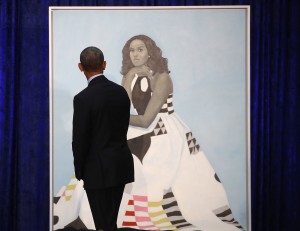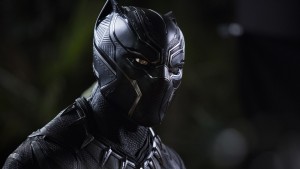Arts News You Can Use
ArtandSeek.net February 19, 2018 49Happy Monday! Thanks for checking out Art&Seek’s weekly look at the biggest and most important stories in the North Texas arts scene.
Things You Ought To Look At
Today’s Presidents’ Day, so I figured I’d kick things off with a look at some of the thoughts and opinions shared after last week’s unveiling of the official Obama Portraits by Kehinde Wiley and Amy Sherald – portraitists who were seen as artists who could buck the trend of forgettable presidential paintings.

Former President Barack Obama and artist Kehinde Wiley unveil his portrait during a ceremony at the Smithsonian’s National Portrait Gallery.
Photo: Mark Wilson/Getty Images via NPR
Wiley’s (of course) the New York City-based portrait painter who’s known for his highly naturalistic paintings of African-Americans. He’s wowed crowds at the Modern Art Museum of Fort Worth twice in the past 10 years, including an exhibit that ran September 2015-January 2016. His painting of the former president has Obama leaning forward in a chair against a lush background of thick, green leaves. He told NPR, “It’s one of those things that can, in a sense, remain stodgy unless you reinvigorate it with a new sense of urgency,” while discussing his non-typical approach to the portrait. Vinson Cunningham has written a beautiful piece for “The New Yorker” that shines a light on the flora in Wiley’s portrait representing the stations of Obama’s scattered personal and ancestral past – blue lilies for Kenya; jasmine for Hawaii; chrysanthemums for Chicago. He also reflects on the captivating story that delivered him into the nation’s arms.

Barack Obama gazes at his wife’s newly unveiled portrait on Monday. The painting of Michelle Obama will be on display through November in the National Portrait Gallery’s “Recent Acquisitions” section.
Photo: Mark Wilson/Getty Images via NPR
Unlike Wiley, the artwork of Michelle Obama’s portraitist is far less popular or well-known to average arts enthusiast. But the former First Lady says the bright colors, geometric patterns and the gray, charcoal-color that Sherald uses to paint African-Americans grabbed the her attention before they even met. “I’d seen her work, and I was blown away by the boldness of her colors and the uniqueness of her subject matter. So I was wondering, who is this woman?” Sharald is a 44-year-old artist who lives in Baltimore. She told NPR the rest of her story. Check it out. And if you don’t like the portrait, read this.
And finally, if you wanna hear an awesome story about another presidential portrait, listen to the story of why LBJ called his presidential portrait the ugliest thing he ever saw.
More Stuff To Look At
- Drawing Inspiration From Turmoil; Sketching A Brighter Future (Art&Seek)
- Denton Fracking Documentary Now on YouTube (The Dentonite)
- Mueck’s Eerily Lifelike Sculptures Return To Modern, Contrast With Works At Amon Carter (Star-Telegram)
- Memory, Mind, Matter: The Sculpture of Eduardo Chillida at Meadows Museum, Southern Methodist University (Arts+Culture)
- The More You Know (Theater Jones)
- Ten Texas Artworks About Love (Glasstire)
Things You Ought To Know

Issues of Fangoria Magazine. It was once the most prominent horror publication in the world.
Photo: via Fangoria Magazine.
Fangoria Magazine was the most prominent horror publication in the world during the ’80s and ’90s. Then due to revenue and printing costs it died in 2016. But if you visit the magazine’s website, the words “NEW BLOOD” fill the page.
A resurrection is occurring and the Dallas-based entertainment company Cinestate is responsible for the rebirth. Cinestate’s CEO Dallas Sonnier says, he’s going to put the magazine back in print, make podcasts under the brand’s umbrella, and get to work on producing more horror movies and financing horror novels.
Sonnier spoke with D Magazine about the take over, how Fangoria fits into Cinestate’s future and reveals feeling like a kid when he scoured the 300 issues of ‘Fangoria’ that were archived and moved to Dallas from New York.
More Stuff To Know
- In North Texas, A Theater Festival Packs A Big Punch (Art&Seek)
- Latinx de Denton: Casa de Monstros (The Dentonite)
- The Front Edge of Theater Making: AT&T’s Off Broadway on Flora (Arts+Culture)
- Meadows Museum Acquires Painting in Honor of Late Curator Nicole Atzbach (Glasstire)
- How the Arts Can Help Immigrant Communities Through Sanctuary (Hyperallergic)
Things You Ought To Read
In recent years, funding for the arts has shifted from corporations to individuals. And an article by American Theatre magazine says that despite being very much like other nonprofits that theaters may be in considerably better shape than other kinds of organizations that’re chasing the same dollars.
Zannie Voss, SMU’s director of the National Center for Arts Research (NCAR), says, “Theatres have been able to continually make investments in fundraising that generate additional contributed revenue, which is not the case for many of the other sectors.”
But Art&Seek’s Jerome Weeks reminds us that the Theatre Communications Group – the folks behind ‘American Theatre’ – have a recent study that indicates while contributing income is increasing, revenue from ticket sales and subscripts is flat or declining.
So maybe it’s not all good news?
More Stuff To Read
- Here Be Monsters: Reviewing The DTC’s ‘Frankenstein’ And Theatre Three’s ‘Jekyll & Hyde’ (Art&Seek)
- A Lonely Watchdog In Denton Suddenly Finds New Allies As He Fights To Update A Dark History (Dallas Morning News)
- The Museum of Street Culture Wants You To Rethink Homelessness (D Magazine)
- Save the Kalita and These 9 Other Historic Dallas Buildings, Too (Dallas Observer)
- Is ‘Gentrification’ A Dirty Word? Artists, Journalists And More Invite You To Discussions At Wild Detectives (Dallas Morning News)
- 37 Artists Native to the Americas Weave Stories of Migration and Geography (Hyperallergic)
Things You Ought To Listen To

The triangular patterns visible in Chadwick Boseman’s Black Panther suit reflect what costume designer Ruth Carter calls “the sacred geometry of Africa.”
Photo: Matt Kennedy/Marvel Studios
Marvel Studios released the 18th film in their ever-expanding cinematic universe this weekend and ‘Black Panther‘ garnered a whopping $201.8 million domestically over three days.
Now normally, I wouldn’t have included ‘Black Panther’ in the ‘Things You Ought To Listen To’ category of this article, but NPR did lots of amazing coverage on the film and I thought I should share some highlights (even though there are even more at NPR.org).
Actress and playwright Danai Gurira – who portrays Okoye, the leader of a group of female warriors that protect the Black Panther’s non-superhero identity King T’Challa – says describes her character as a protector of what would have been in an interview with Michel Martin.
Costume designer Ruth Carter — whose previous films include Selma, Malcolm X and Roots — pulled colors, shapes, jewelry, and textures from tribes all over Africa. She says she wanted to tell a story “of brilliance, royalty, intrigue — you name it. I feel that you can tell a story through clothing.” Listen to that here.
And director Ryan Coogler tells David Greene that working on this film brought him closer to his roots. “You look at any society in any period of time,” Coogler explains, “they had their version of how they did their myth-making. Whether it was vaudeville, whether it was plays, whether it was on the plains of Africa … Right now, it’s these big, huge, large-canvas films.” Coogler is known for much smaller films like the acclaimed “Fruitvale Station.” But delving into African heritage to get portions of his blockbuster right, were what he needed to feel connected.
Film critic David Edelstein explains how having the mythic Black Panther represent for young black people is also monuments for popular culture.
More Stuff To Listen To
- An Ordinary Boy: Conspirare’s “Considering Matthew Shepard” (Art&Seek)
- Songs Of The Week: David Morgan, Luna Luna & More (Central Track)
- A Town In Mexico Sees Guitar Sales Soar Thanks To The Movie ‘Coco’ (NPR)
- At 80, Judy Blume Reflects On Feminism, #MeToo And Keeping Margaret 12 (NPR)
- It’s A Beautiful 50th Birthday For ‘Mister Rogers’ Neighborhood’ (NPR)
- The Big Screen: ‘Dunkirk’ and ‘Darkest Hour’ (Art&Seek)











